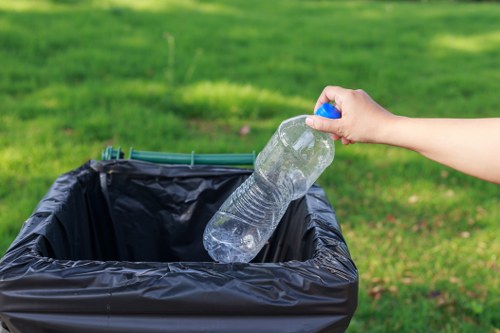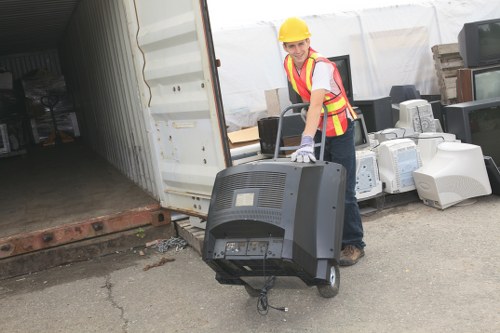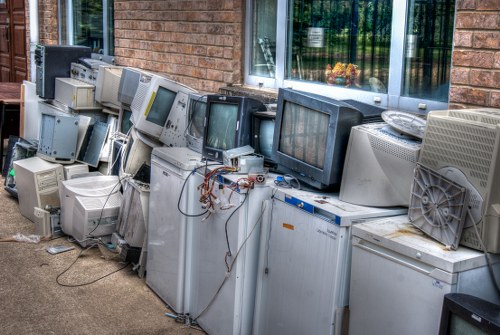Builders Waste Clearance in Tooting: Efficient and Reliable Solutions

When undertaking any construction or renovation project in Tooting, one crucial aspect that often gets overlooked is the proper clearance of builder's waste. Effective builders waste clearance not only ensures compliance with local regulations but also contributes to a safer and more organized working environment. In this comprehensive guide, we delve into the various facets of builders waste clearance in Tooting, highlighting its importance, the processes involved, and the best practices to follow.
Builders waste can range from construction debris such as concrete, bricks, and wood to packaging materials, old fixtures, and hazardous substances. Managing this waste efficiently is essential to prevent environmental pollution, reduce clutter, and ensure the smooth progression of construction activities.
Tooting, a vibrant district in South London, has seen significant development over the years, leading to an increase in construction projects. With this growth comes the responsibility of handling the resulting waste in an environmentally friendly and cost-effective manner.

Understanding Builders Waste
Builders waste encompasses a wide variety of materials generated during the construction, renovation, and demolition of buildings. These materials can be categorized into different types based on their composition and potential for recycling or disposal.
Types of Builders Waste
- Inert Waste: Includes materials like concrete, bricks, and rubble that do not decompose and can be recycled.
- Non-Inert Waste: Comprises materials such as wood, metals, plastics, and glass that can be recycled or repurposed.
- Hazardous Waste: Contains substances like asbestos, paint, solvents, and chemicals that require special handling and disposal methods.
Proper classification of builders waste is the first step towards effective waste management. It ensures that each type of waste is handled appropriately, minimizing environmental impact and promoting sustainability.

Importance of Builders Waste Clearance
Effective builders waste clearance offers numerous benefits, both for construction projects and the broader community. Some of the key advantages include:
- Environmental Protection: Proper disposal and recycling of waste materials reduce pollution and conserve natural resources.
- Compliance with Regulations: Adhering to local waste management laws helps avoid legal penalties and promotes responsible construction practices.
- Cost Efficiency: Efficient waste management can lower disposal costs and even generate revenue through recycling.
- Safety: A clutter-free site minimizes the risk of accidents and ensures a safer working environment for construction workers.
In Tooting, where community spaces and residential areas are in close proximity to construction sites, maintaining high standards of waste clearance is particularly crucial.

Builders Waste Clearance Process
The process of builders waste clearance involves several steps, each designed to ensure that waste is managed responsibly and efficiently. Here’s an overview of the typical process:
1. Waste Assessment
Before commencing any clearance work, it's essential to assess the type and volume of waste generated. This assessment helps in planning the appropriate disposal methods and determining the necessary resources.
2. Sorting and Segregation
Once assessed, waste materials are sorted into different categories based on their type and recyclability. Proper segregation is vital for efficient recycling and disposal.
3. Collection and Transportation
The sorted waste is then collected and transported to designated facilities. Choosing a reliable waste clearance service ensures that this step is carried out smoothly and in compliance with regulations.
4. Recycling and Disposal
Recyclable materials are processed for reuse, while non-recyclable waste is disposed of in an environmentally friendly manner. Hazardous waste requires specialized treatment to prevent environmental contamination.
5. Documentation and Compliance
Maintaining records of waste clearance activities is essential for regulatory compliance and accountability. Proper documentation helps in tracking waste management practices and ensuring adherence to local laws.

Choosing the Right Builders Waste Clearance Service in Tooting
Selecting a reliable builders waste clearance service is critical to the success of any construction project. Here are some factors to consider when making your choice:
1. Experience and Expertise
Choose a service provider with a proven track record in builders waste clearance. Experienced companies are better equipped to handle various types of waste and can offer tailored solutions to meet your project's specific needs.
2. Compliance with Regulations
Ensure that the service provider complies with local waste management laws and regulations. This includes proper licensing and adherence to safety standards.
3. Range of Services
Opt for a company that offers a comprehensive range of services, including waste assessment, sorting, transportation, recycling, and disposal. A full-service provider can streamline the waste management process and reduce logistical challenges.
4. Environmental Commitment
Choose a company committed to environmentally friendly practices. This includes recycling as much waste as possible and minimizing the environmental impact of disposal methods.
5. Cost-Effectiveness
Compare pricing among different service providers to ensure you receive quality service at a competitive rate. Transparent pricing with no hidden fees is a sign of a trustworthy company.
Top Builders Waste Clearance Providers in Tooting
- Tooting Waste Solutions: Known for their comprehensive services and commitment to recycling.
- EcoClear Tooting: Specializes in eco-friendly waste management and hazardous waste disposal.
- FastTrack Clearance: Offers rapid waste clearance services with flexible scheduling options.

Best Practices for Builders Waste Clearance
Implementing best practices in builders waste clearance can enhance efficiency and sustainability. Here are some recommendations:
1. Plan Ahead
Develop a waste management plan at the outset of your project. This plan should outline waste generation estimates, disposal methods, and recycling opportunities.
2. Educate the Team
Ensure that all team members are aware of waste management protocols. Proper training can facilitate effective segregation and disposal of waste.
3. Maximize Recycling
Identify materials that can be recycled or reused. Partner with recycling facilities to divert waste from landfills and promote sustainability.
4. Minimize Waste Generation
Adopt construction practices that reduce waste generation. This includes precise material ordering, efficient cutting techniques, and using reusable forms and molds.
5. Monitor and Review
Regularly monitor waste management activities and review practices to identify areas for improvement. Continuous assessment ensures that waste clearance remains efficient and compliant.
Environmental Impact and Sustainability
Builders waste clearance plays a significant role in environmental conservation. By reducing landfill usage and promoting recycling, construction projects can minimize their ecological footprint. Sustainable waste management practices contribute to the overall goal of creating greener and more resilient communities in Tooting.

Costs Associated with Builders Waste Clearance
The cost of builders waste clearance in Tooting can vary based on several factors. Understanding these factors can help you budget effectively and choose a service that offers the best value for your investment.
Factors Influencing Costs
- Volume of Waste: The amount of waste generated directly impacts the cost. Larger projects with more waste will incur higher clearance fees.
- Type of Waste: Hazardous or specialized waste requires more careful handling and disposal, leading to higher costs compared to inert or recyclable materials.
- Service Scope: Comprehensive services that include assessment, sorting, transportation, and disposal will be priced higher than basic clearance services.
- Frequency of Clearance: Regular, scheduled clearances might offer cost savings compared to one-time services due to reduced logistical expenses.
- Location: Proximity to disposal facilities and the specific area within Tooting can affect transportation costs.
Cost-Saving Tips
- Accurate Waste Estimation: Providing an accurate estimate of the waste volume can prevent unexpected costs and ensure appropriate resource allocation.
- Recycling and Reuse: Maximizing recycling can reduce disposal fees and sometimes generate additional revenue from reusable materials.
- Bundle Services: Combining waste clearance with other services like demolition or construction can lead to bundled discounts.
- Regular Clearance Schedule: Implementing a regular clearance schedule can optimize efficiency and reduce overall costs.
- Choose Local Providers: Selecting a local waste clearance service can minimize transportation costs and support the local economy.
By carefully considering these factors and implementing cost-saving strategies, you can manage your builders waste clearance expenses effectively without compromising on quality or compliance.

Regulations and Compliance in Tooting
Builders waste clearance in Tooting must comply with various local and national regulations to ensure environmental protection and public safety. Understanding these regulations is essential for any construction project in the area.
Local Regulations
Local authorities in Tooting have specific guidelines governing waste management practices. These include:
- Waste Disposal Licenses: Obtaining the necessary licenses for waste transportation and disposal is mandatory.
- Recycling Requirements: Certain materials must be separated and recycled as per local mandates.
- Environmental Protection Standards: Regulations aimed at minimizing environmental impact, such as restrictions on landfill use and emissions from waste transport vehicles.
National Regulations
On a broader scale, national regulations also govern builders waste clearance:
- Environmental Protection Act: Sets the framework for waste management practices, including disposal and recycling standards.
- Hazardous Waste Regulations: Outline specific procedures for handling, storing, and disposing of hazardous materials.
- Building Regulations: Include provisions related to waste management during construction and demolition activities.
Penalties for Non-Compliance
Failure to comply with waste management regulations can result in severe penalties, including fines, legal action, and project delays. Ensuring adherence to all relevant laws is crucial for the smooth progression of construction projects.
Staying Updated
Regulations can evolve, so it is important to stay informed about any changes in waste management laws. Partnering with a knowledgeable builders waste clearance service can help ensure ongoing compliance.

Technology in Builders Waste Clearance
Advancements in technology have transformed builders waste clearance, making it more efficient and environmentally friendly. Here are some of the technological innovations shaping the industry:
1. Waste Management Software
Modern waste management software allows for better tracking, sorting, and reporting of waste materials. This ensures accurate assessments and improves overall efficiency.
2. Recycling Technologies
Innovations in recycling technologies enable the processing of a wider range of materials, increasing the recycling rate and reducing landfill dependency.
3. Automated Sorting Systems
Automated systems can quickly and accurately sort different types of waste, reducing the need for manual labor and minimizing errors.
4. GPS and Routing Software
GPS technology and sophisticated routing software optimize waste collection routes, saving time and reducing fuel consumption.
5. Sustainable Disposal Methods
Eco-friendly disposal methods, such as anaerobic digestion for organic waste or thermal treatment for certain materials, help mitigate environmental impact.
Future Trends
The future of builders waste clearance lies in further technological integration, focusing on increased automation, enhanced recycling capabilities, and the development of more sustainable disposal methods. Embracing these advancements will lead to more efficient and environmentally responsible waste management practices in Tooting.

Case Studies: Successful Builders Waste Clearance in Tooting
Examining successful builders waste clearance projects in Tooting provides valuable insights into effective waste management strategies. Here are a few notable examples:
Project A: Renovation of a Residential Complex
During the renovation of a large residential complex, the waste clearance team implemented a comprehensive sorting and recycling system. By segregating materials on-site, they achieved a recycling rate of over 70%, significantly reducing landfill waste and lowering disposal costs.
Project B: Commercial Office Building Construction
In the construction of a commercial office building, the waste clearance service utilized GPS routing software to optimize waste collection routes. This approach minimized transportation time and fuel usage, leading to more efficient operations and reduced environmental impact.
Project C: Demolition of an Old Warehouse
The demolition of an old warehouse involved handling a substantial amount of hazardous waste, including asbestos. The clearance team adhered strictly to safety protocols and regulatory requirements, ensuring the safe and compliant disposal of all hazardous materials.
Lessons Learned
These case studies highlight the importance of strategic planning, adherence to regulations, and the integration of advanced technologies in achieving successful builders waste clearance outcomes. Implementing best practices can lead to significant environmental and economic benefits.

Benefits of Recycling in Builders Waste Clearance
Recycling plays a pivotal role in builders waste clearance, offering numerous benefits that extend beyond cost savings. Here are some of the key advantages:
- Resource Conservation: Recycling conserves natural resources by reusing materials, reducing the need for virgin materials in construction.
- Energy Savings: Producing materials from recycled inputs often requires less energy compared to manufacturing from raw materials.
- Environmental Protection: Recycling reduces the volume of waste sent to landfills, decreasing pollution and greenhouse gas emissions.
- Economic Benefits: Recycling can create job opportunities and stimulate the local economy through the development of recycling facilities and related services.
- Compliance and Reputation: Engaging in recycling practices helps construction firms comply with regulations and enhances their reputation as environmentally responsible entities.
In Tooting, promoting recycling within builders waste clearance not only supports sustainability goals but also aligns with the community's commitment to environmental stewardship.

Challenges in Builders Waste Clearance
Despite the clear benefits, builders waste clearance faces several challenges that need to be addressed to ensure effective management. Some of the common challenges include:
1. Waste Segregation
Properly segregating waste at the source can be difficult, especially on large construction sites with high activity levels. Inadequate segregation can lead to contamination and reduced recycling rates.
2. Limited Recycling Facilities
Access to specialized recycling facilities for certain materials can be limited in Tooting, making it challenging to manage diverse waste streams effectively.
3. Regulatory Compliance
Keeping up with changing regulations and ensuring compliance can be resource-intensive, particularly for smaller construction firms.
4. Cost Constraints
Effective waste management solutions can be costly, and budget constraints may limit the ability to implement comprehensive clearance strategies.
5. Public Awareness
Limited awareness among construction workers and stakeholders about the importance of proper waste management can hinder efforts to improve clearance practices.
Overcoming the Challenges
Addressing these challenges requires a combination of education, investment in infrastructure, collaboration with waste management experts, and the adoption of innovative technologies. By tackling these obstacles, builders in Tooting can enhance their waste clearance processes and contribute to a more sustainable construction industry.

Innovative Solutions for Builders Waste Clearance
To overcome the challenges in builders waste clearance, innovative solutions are being implemented in Tooting. These solutions focus on improving efficiency, enhancing recycling rates, and reducing environmental impact.
1. On-Site Waste Processing
Implementing on-site waste processing facilities allows for immediate sorting and recycling of materials. This reduces the need for transportation and lowers the overall carbon footprint of waste management activities.
2. Digital Tracking Systems
Digital tracking systems enable real-time monitoring of waste generation and disposal. This data-driven approach helps in optimizing waste management strategies and ensuring compliance with regulations.
3. Collaborative Waste Management
Collaborating with local recycling centers, construction firms, and waste clearance services fosters a more integrated and efficient waste management ecosystem. Shared resources and expertise can lead to better outcomes.
4. Sustainable Material Choices
Choosing sustainable materials that are easier to recycle or have a lower environmental impact can significantly reduce the volume and complexity of builders waste.
5. Education and Training Programs
Providing education and training for construction workers on best practices in waste management promotes a culture of sustainability and ensures that waste clearance procedures are followed correctly.
Future Innovations
The future of builders waste clearance in Tooting lies in the continued adoption of smart technologies, enhanced recycling techniques, and sustainable construction practices. Embracing these innovations will drive the industry towards greater efficiency and environmental responsibility.

Case for Sustainable Builders Waste Clearance
Sustainability is at the forefront of modern construction practices. Sustainable builders waste clearance not only addresses environmental concerns but also offers long-term economic benefits.
Environmental Benefits
- Reduced Landfill Use: By recycling and reusing materials, the reliance on landfills decreases, mitigating the environmental issues associated with landfill sites.
- Lower Carbon Footprint: Sustainable waste management practices, including energy-efficient recycling processes, contribute to a lower carbon footprint for construction projects.
- Preservation of Resources: Recycling conserves natural resources, ensuring that materials are available for future construction needs.
Economic Benefits
- Cost Savings: Efficient waste management can lead to significant cost savings through reduced disposal fees and material reuse.
- Increased Property Value: Sustainable construction practices enhance the appeal and value of properties, attracting environmentally conscious buyers and tenants.
- Market Competitiveness: Embracing sustainability can differentiate construction firms in a competitive market, attracting clients who prioritize eco-friendly practices.
Social Benefits
- Community Health: Reducing waste and preventing environmental pollution contributes to better health outcomes for the local community.
- Job Creation: The recycling and waste management sectors create employment opportunities, supporting the local economy.
- Enhanced Reputation: Sustainable practices build trust and enhance the reputation of construction firms within the community.
Integrating Sustainability into Builders Waste Clearance
To fully realize the benefits of sustainable builders waste clearance, it is essential to integrate sustainability into every aspect of waste management. This includes selecting eco-friendly materials, investing in recycling technologies, educating the workforce, and continuously seeking ways to reduce waste. By prioritizing sustainability, construction projects in Tooting can achieve long-term success while contributing positively to the environment and society.

Contact Us for Your Builders Waste Clearance Needs in Tooting
Managing builders waste effectively is a critical component of any construction or renovation project. With the right waste clearance strategies, you can ensure compliance, promote sustainability, and maintain a safe and organized site.
At [Your Company Name], we specialize in providing comprehensive builders waste clearance services in Tooting. Our experienced team is equipped to handle all types of construction waste, ensuring that your project runs smoothly and efficiently.
- Comprehensive waste assessment and planning
- Efficient sorting and segregation of materials
- Eco-friendly recycling and disposal methods
- Compliance with all local and national regulations
- Competitive pricing tailored to your project needs
Don’t let builders waste clearance become a hurdle for your project. Contact us today to discuss your requirements and receive a customized waste management solution that aligns with your goals.
Book your service now and take the first step towards a cleaner, safer, and more sustainable construction site in Tooting.
